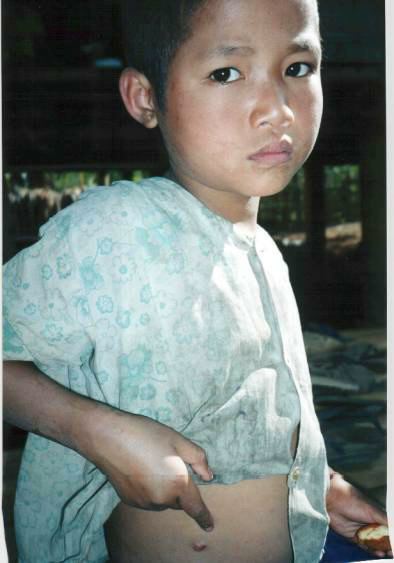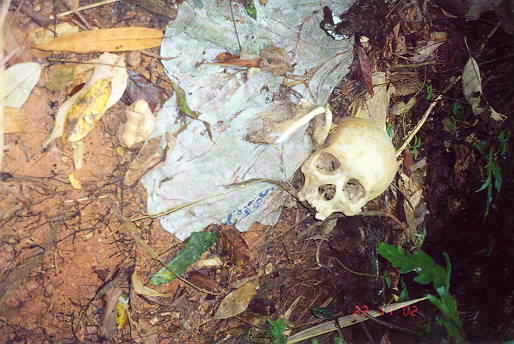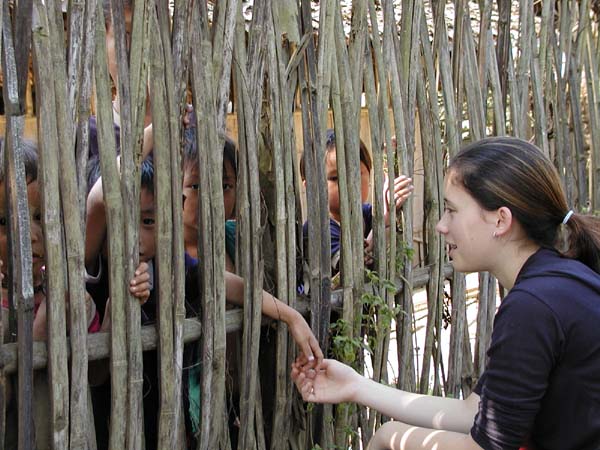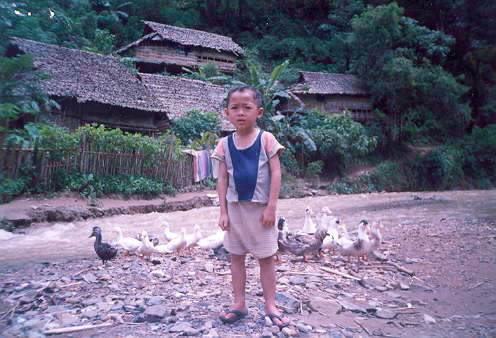REASONS
TO BE A REFUGEE
Under the rule of the SPDC, the mountainous regions populated by Burma's minority
ethnic groups are punctuated with “Death Zones.” Anyone caught
in these areas is killed by the Burmese Army. There is no distinction made between
a resistance fighter and civilian non-combatants (including women, children
and the elderly). One example of a death zone is the territory surrounding the
Unocal/TotalFinaElf pipeline, which was forceably depopulated during the pipeline's
construction. No one is allowed to enter this area. Another example is the region
that is the prospective location of the new dam being developed on the Salween
River. This too is a death zone.
However, the Burmese Army does not need the presence of a death zone to justify
wholesale slaughter. It will use any pretext - that a village may harbor sympathizers
of resistance forces, that there are crops and livestock to steal, or that there
are young girls to rape - to commit the most horrendous acts imaginable. The
SPDC truly are the Taleban of Southeast Asia.
It is for these reasons that many villagers become refugees, although the life
refugees encounter is in many cases little better than that from which they
have fled.
Photo sources: 1st - Karen Action Group; 2nd - FBR; 3nd-5th - Saw Takkaw; 6th-7th
- Saw Htee Doh; 8th-9th - International Assistance Group, Inc.

This is Naw Moo Day Wah, 8 years old. On October 30, 2002, SPDC Light Infantry
Battalion 235 attacked Karen villagers (the Karen are a hill-based ethnic group)
in the Ler Mu Plaw area, Lu Thaw township, Mu Traw (Papun) district. At one
farm, where everyone was harvesting rice, the SPDC killed Saw Ri Ba Wah (male
- 35) and wounded Saw Thay Bay Wah (40), Saw Sri Nay Moo (17), Saw Ti Tu (17),
Naw Ler Per (female - 14), and Naw Moo Day Wah.
Naw Moo Day Wah was shot in the right side, where the bullet remained. There
was no clinic nearby, and the villagers could not carry her because of her great
pain. After six days some medics arrived, but were unable to help her because
they did not have surgical equipment.
February 24, 2003 correction: Originally we reported that Naw Moo Day Wah died.
After the medics arrived, she went into a coma. The medics reported by radio
that she was dying, and would survive one more day at most. This was misinterpreted
on the receiving end that she had already died. Remarkably, though, she pulled
through.

This is a recent photo of Naw Moo Day Wah, taken by another humanitarian team.
The bullet is still inside her. In this case you could say that the story had
a happy ending, but not really. One man died and five others will carry their
scars for life. Furthermore, these attacks, which defy comprehension for anyone
with a shred of morality, remain commonplace in the mountain villages along
the border with Thailand.

These are the remains of
a porter, forced into service by the SPDC and then murdered, likely in October
2002. The porter (the gender is unknown) was conscripted during rainy season
operations by the Burmese Army. His or her body was dumped in a swollen stream,
and only discovered after the rains ended and the stream dried out. Porters
suffer hunger, dehydration, exhaustion and malaria. They are murdered if they
cannot carry their assigned loads or if they cannot keep pace with the Army
column. Porters are also regularly beaten, and if they are women, raped.
The use of porters is commonplace in SPDC-controlled areas.

This individual, “Saw
Chakla,” was shot while tending his farm in 2000. No warning was given.
Of course, one might wonder: why recall such a long-past event. It's not from
yesterday, or today, or even tomorrow. It's not new news!
The reason is that these people suffered. They were victims of criminal behavior,
and they deserve to have their stories told. More than anything, they deserve
justice. With effort, we can get them justice, but even if that proves unobtainable
their stories are a warning to us all of the abuses that inevitably occur when
great power is centralized. Power is increasingly centralized now, all around
the world, and we - even you - may be its next victims.

This is a family of internally displaced persons (IDPs). They arrived at the
Thai border on October 18, 2002 but were refused entry. They currently are hiding
in a small shelter on Burma's side of the border. They fled Myitta Forced Relocation
Camp (a camp to which villagers from depopulated villages were forced to relocate),
after the SPDC discovered that the oldest son (not in the photo) was a resistance
fighter. The SPDC attempted to murder the father, but the family was able to
escape.
On December 29, 2002, Thailand's National Security Commission announced: “From
this time on, Thailand will cease to grant asylum to refugees from Burma. It
is Thai government policy to close refugee camps and to repatriate all refugees
back to Burma in the near future.” Since that date, however, refugees
have continued to flood into Thailand, for the reasons described above. On February
7, 2003, the Thai government, claiming that there was no fighting currently
taking place in the border areas, ordered officials in Mae Hong Song province
to expel Karen refugees trying to cross into Thailand.


These are some of the refugees that may be repatriated, and face a future like
Naw Moo Day Wah.
Interestingly, the girl in the photo touching the hand of the child is half-Karen.
The half that is not Karen, though, creates a divide that it is impossible to
cross. Society in Thailand has a distinctive structure. At the top are the “Real
Thai,” ethnic Thai, and for them the best of the best are the wealthiest,
the Chinese Thai (Thais who have some Chinese ancestors), and those with the
lightest skin color. (The wealthiest are predominantly the Chinese Thai, who
also have the lightest skin color.) Under them, but also real Thai, are the
regional populations, such as in the Northeast, or Isan, who generally
have darker skin. Under them are other Asians (not including Thailand's other
ethnic groups), then farangs, or foreigners of European descent, and
then the groups that are considered (by many but of course not by all Thais)
to be subhuman, including Africans and members of Thailand's other ethnic groups,
particularly the hill groups. While this is not well known in the West, Thailand
is a remarkably racist, and classist, society. (Again, there are large numbers
of Thais who are not racist at all.) Of course, many if not most Asian nations
have these same social beliefs and structures.

Saw Klo Eh Moo (7). He has two brothers.

Saw Nay Kaw (7)
These distinctions, on
the basis of wealth, skin color and ethnicity, are not benign. These two boys
live in Mae Kong Kha Refugee Camp. They too may be repatriated. But if this
happens, they will leave without their fathers. Mae Kong Kha, like many refugee
camps, is squalid and poorly located. It suffered a terrible flood on September
2, 2002, in which some thirty refugees died, including their fathers. (Saw Nay
Kaw is standing in the flood path that took his father.)
This is the life of a refugee. They flee the worst conditions imaginable, only
to be treated horribly and also blamed for their own suffering. It is of course
difficult for any nation to host refugees, and it is a plus for Thailand that
at least in the past it has been willing to accept them. But under the current
administration, of Prime Minister Thaksin Shinawatra (a Chinese Thai and reportedly
the second richest man in the country), Thailand has turned its back on its
record of (minimal) compassion, and it is now siding with the criminals who
are responsible (one of whom, Lt. Gen. Khin Nyunt of the SPDC, is a business
partner with Thaksin).
The current Thai government has the audacity to use doublespeak and state that
repatriation will solve the refugees' problems. All it will really do is lead
to untold suffering, and generate even greater wealth for the upper class Thais
who have the right connections.








